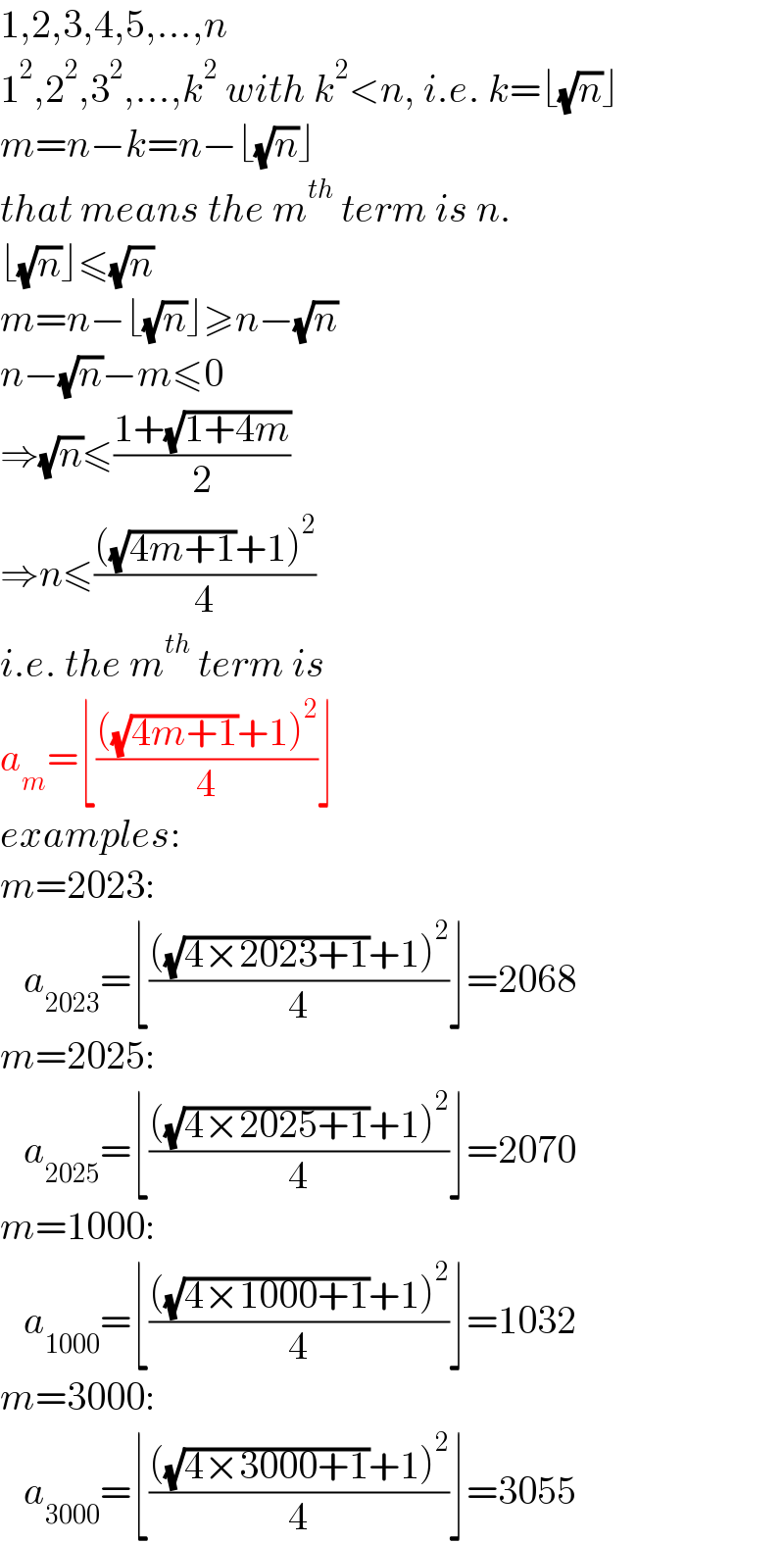
Question Number 202306 by hardmath last updated on 24/Dec/23

$$ \\ $$Find the 2023rd term in the sequence 2,3,5,6,7,8,10,11,12,13,14,15,17,18,... obtained by subtracting integer squares from natural numbers.
Answered by deleteduser1 last updated on 24/Dec/23

$$\mathrm{1},\mathrm{2},\mathrm{3},...,\mathrm{2023}\:{contains}\:\mathrm{44}\:{squares} \\ $$$$\Rightarrow\mathrm{2023}\:{is}\:{the}\:\left(\mathrm{2023}−\mathrm{44}=\mathrm{1979}\right){th}\:{term} \\ $$$$\mathrm{2023}−\mathrm{1979}{th}\:{term} \\ $$$$\mathrm{2023}+\mathrm{44}−\mathrm{2022}{nd}\:{term};\:{since}\:\mathrm{45}^{\mathrm{2}} =\mathrm{2025} \\ $$$$\Rightarrow\mathrm{2023}{rd}\:{term}=\mathrm{2023}+\mathrm{45}=\mathrm{2068} \\ $$
Commented by hardmath last updated on 24/Dec/23

$$\mathrm{thank}\:\mathrm{you}\:\mathrm{dear}\:\mathrm{professor} \\ $$
Answered by mr W last updated on 24/Dec/23

$$\mathrm{1},\mathrm{2},\mathrm{3},\mathrm{4},\mathrm{5},...,{n} \\ $$$$\mathrm{1}^{\mathrm{2}} ,\mathrm{2}^{\mathrm{2}} ,\mathrm{3}^{\mathrm{2}} ,...,{k}^{\mathrm{2}} \:{with}\:{k}^{\mathrm{2}} <{n},\:{i}.{e}.\:{k}=\lfloor\sqrt{{n}}\rfloor \\ $$$${m}={n}−{k}={n}−\lfloor\sqrt{{n}}\rfloor \\ $$$${that}\:{means}\:{the}\:{m}^{{th}} \:{term}\:{is}\:{n}. \\ $$$$\lfloor\sqrt{{n}}\rfloor\leqslant\sqrt{{n}} \\ $$$${m}={n}−\lfloor\sqrt{{n}}\rfloor\geqslant{n}−\sqrt{{n}} \\ $$$${n}−\sqrt{{n}}−{m}\leqslant\mathrm{0} \\ $$$$\Rightarrow\sqrt{{n}}\leqslant\frac{\mathrm{1}+\sqrt{\mathrm{1}+\mathrm{4}{m}}}{\mathrm{2}}\: \\ $$$$\Rightarrow{n}\leqslant\frac{\left(\sqrt{\mathrm{4}{m}+\mathrm{1}}+\mathrm{1}\right)^{\mathrm{2}} }{\mathrm{4}} \\ $$$${i}.{e}.\:{the}\:{m}^{{th}} \:{term}\:{is} \\ $$$${a}_{{m}} =\lfloor\frac{\left(\sqrt{\mathrm{4}{m}+\mathrm{1}}+\mathrm{1}\right)^{\mathrm{2}} }{\mathrm{4}}\rfloor \\ $$$${examples}: \\ $$$${m}=\mathrm{2023}:\: \\ $$$$\:\:\:{a}_{\mathrm{2023}} =\lfloor\frac{\left(\sqrt{\mathrm{4}×\mathrm{2023}+\mathrm{1}}+\mathrm{1}\right)^{\mathrm{2}} }{\mathrm{4}}\rfloor=\mathrm{2068} \\ $$$${m}=\mathrm{2025}:\: \\ $$$$\:\:\:{a}_{\mathrm{2025}} =\lfloor\frac{\left(\sqrt{\mathrm{4}×\mathrm{2025}+\mathrm{1}}+\mathrm{1}\right)^{\mathrm{2}} }{\mathrm{4}}\rfloor=\mathrm{2070} \\ $$$${m}=\mathrm{1000}: \\ $$$$\:\:\:{a}_{\mathrm{1000}} =\lfloor\frac{\left(\sqrt{\mathrm{4}×\mathrm{1000}+\mathrm{1}}+\mathrm{1}\right)^{\mathrm{2}} }{\mathrm{4}}\rfloor=\mathrm{1032} \\ $$$${m}=\mathrm{3000}: \\ $$$$\:\:\:{a}_{\mathrm{3000}} =\lfloor\frac{\left(\sqrt{\mathrm{4}×\mathrm{3000}+\mathrm{1}}+\mathrm{1}\right)^{\mathrm{2}} }{\mathrm{4}}\rfloor=\mathrm{3055} \\ $$
Commented by hardmath last updated on 24/Dec/23

$$\mathrm{perfect}\:\mathrm{solution}\:\mathrm{tahnkyou}\:\mathrm{dear}\:\mathrm{professor} \\ $$
